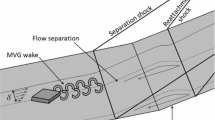Abstract
Micro vortex generator (MVG) is a kind of robust and practical devices used to control the boundary layer. This research implements a set of large eddy simulations (LES) on the flow field in the downstream of the micro vortex generator (MVG) in supersonic flows with different Mach numbers. In this study, the downstream flow field affected by MVG at different Mach numbers was analyzed in detail, especially the large vortex structure generated in the upper boundary layer that plays a very important role in shock boundary layer interaction (SBLI). Studies have found that the incoming Mach number does not have a major impact on the generation mechanism of ring-like vortices, but it will affect the strength and length of the momentum deficit behind the MVG, thereby affecting the position of the vortex structure relative to the boundary layer and its intensity. At a high Mach number, the momentum deficit is located closer to the lower boundary layer so that the resulting upper vortex structure has more opportunity to interact with the structure in the lower boundary layer. This makes the upper vortex structure more distorted. Moreover, the power spectrum analysis of the frequency of ring-like vortices generated at different Mach numbers was also conducted in this research.











Similar content being viewed by others
Abbreviations
- MVG:
-
Micro vortex generator
- SBLI:
-
Shock wave-boundary layer interaction
- DNS:
-
Direct numerical simulation
- LES:
-
Large eddy simulation
- Ma:
-
Mach number
- Re:
-
Reynolds number based on momentum thickness
- h :
-
Micro ramp height
- x, y, z :
-
Spanwise, normal and streamwise coordinate axes
- u, v, w :
-
Spanwise, normal and streamwise velocity
References
Lin, J.C.: Review of research on low-profile vortex generators to control boundary-layer separation. Progress Aerosp. Sci. 38, 389–420 (2002)
Ashill, P.R., Fulker, J.L., Hackett, K.C.: A review of recent developments in flow control. Aeronaut. J. 109(1095), 205–232 (2005)
Dussauge, J.P., Dupont, P., Debieve, J.F.: Unsteadiness in shock wave boundary layer interaction with separation. Aerosp. Sci. Technol. 10(2), 85–91 (2006)
Estruch-Samper, D., Vanstone, L., Hillier, R., Ganapathisubramani, B.: Micro vortex generator control of axisymmetric high-speed laminar boundary layer separation. Shock Waves 25(5), 521–533 (2015)
Babinsky, H., Li, Y., Ford, C.W.P.: Microramp control of supersonic oblique shock-wave/boundary-layer interactions. AIAA J. 47(3), 668–675 (2009)
Zhang, B., Zhao, Q., Xiang, X., Xu, J.: An improved micro-vortex generator in supersonic flows. Aerosp. Sci. Technol. 47, 210–215 (2015)
Saad, M.R., Zare-Behtash, H., Che-Idris, A., Kontis, K.: Micro-ramps for hypersonic flow control. Micromachines 3(2), 364–378 (2012)
Yan, Y., Li, Q., Liu, C., Pierce, A., Lu, F.: Numerical discovery and experimental confirmation of vortex ring generation by microramp vortex generator. Appl. Math. Model. 36(11), 5700–5708 (2012)
Yan, Y., Liu, C.: Study on the initial evolution of ring-like vortices generated by MVG. CEAS Aeronaut. J. 4(4), 433–442 (2013)
Yan, Y., Liu, C.: Shear layer stability analysis in boundary layer transition and MVG controlled ramp flow. AIAA paper, 2013-053 (2013)
Yan, Y., Liu, C.: Study on the ring-like vertical structure in MVG controlled supersonic ramp flow with different inflow conditions. Aerosp. Sci. Technol. 35, 106–115 (2014)
Yan, Y., Chen, C., Ping, Lu., Liu, C.: Study on shock wave-vortex ring interaction by the micro vortex generator controlled ramp flow with turbulent inflow. Aerosp. Sci. Technol. 30(1), 226–231 (2013)
Towns, J., Cockerill, T., Dahan, M., Foster, I., Gaither, K., Grimshaw, A., Hazlewood, V., Lathrop, S., Lifka, D., Peterson, G.D., Roskies, R., Scott, J.R., Wilkins-Diehr, N.: XSEDE: accelerating scientific discovery. Comput. Sci. Eng. 16(5), 62–74 (2014). https://doi.org/10.1109/MCSE.2014.80
Yan, Y., Chen, L., Li, Q., Liu, C.: Numerical study on microramp vortex generation for supersonic ramp flow control at Mach 2.5. Shock Waves 27(1), 79–96 (2016)
Yan, Y., Tang, J., Liu, C., Yang, F.: DNS study on the formation of lambda rotational core and the role of TS wave in boundary layer transition. J. Turbul. 17(6), 572–601 (2016)
Martín, M.P., Taylor, E.M., Wu, M., Weirs, V.G.: Bandwidth-optimized WENO scheme for the effective direct numerical simulation of compressible turbulence. J. Comput. Phys. 220(1), 270–289 (2006)
Guarini, S.E., Moser, R.D., Shariff, K., Wray, A.: Direct numerical simulation of a supersonic turbulent boundary layer at Mach 2.5. J. Fluid Mech. 414(1), 1–33 (2000)
Sun, Z., Schrijer, F.F.J., Scarano, F. et al.: PIV investigation of the 3D instantaneous flow organization behind a micro-ramp in a supersonic boundary layer. 28th Int Symp Shock Waves. Berlin, Heidelberg: Springer Berlin Heidelberg, p 417–423 (2012)
Ghosh, S., Choi, J.-I., Edwards, J.R.: Numerical simulations of effects of micro vortex generators using immersed-boundary methods. AIAA J. 48, 92–103 (2010)
Lee, S., Loth, E., Wang, C., et al.: LES of supersonic turbulent boundary layers with µVG’s. In: 25th AIAA Appl Aerodyn Conf [Internet]. Miami: American Institute of Aeronautics and Astronautics (2007)
Liu, C., Gao, Y., Dong, X., et al.: Third generation of vortex identification methods: Omega and Liutex/Rortex based systems. J. Hydrodyn. 31, 205–223 (2019)
Acknowledgements
This research is part of the Blue Waters sustained-petascale computing project, which is supported by the National Science Foundation (awards OCI-0725070 and ACI-1238993) the State of Illinois, and as of December, 2019, the National Geospatial-Intelligence Agency. This work was funded in part by the National Science Foundation’s Implementation Grant # 1912191.
Author information
Authors and Affiliations
Corresponding author
Ethics declarations
Conflict of interests
The authors declare that they have no conflict of interest.
Additional information
Publisher's Note
Springer Nature remains neutral with regard to jurisdictional claims in published maps and institutional affiliations.
About this article
Cite this article
Yan, Y., Yang, Y., Chen, C. et al. Numerical study on the ring-like vortex structure generated by MVG in high-speed flows with different Mach numbers. Japan J. Indust. Appl. Math. 39, 3–18 (2022). https://doi.org/10.1007/s13160-021-00484-w
Received:
Revised:
Accepted:
Published:
Issue Date:
DOI: https://doi.org/10.1007/s13160-021-00484-w




